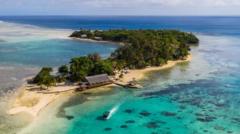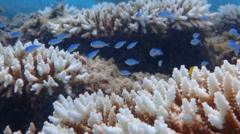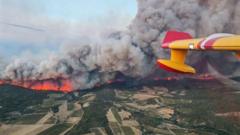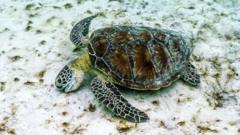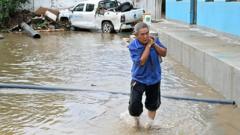The coral, larger than a blue whale, exemplifies hope for resilience against climate change while emphasizing conservation.
**Largest Coral Discovery Offers Hope Amid Climate Change**
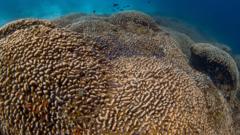
**Largest Coral Discovery Offers Hope Amid Climate Change**
Scientists uncover a colossal coral in the Pacific, raising awareness for climate impact on marine ecosystems.
The world’s largest coral has been unearthed by scientists in the remote southwest Pacific Ocean, marking a significant discovery in marine biology. This mega coral, formed from numerous interlinked tiny organisms, was found to potentially be over 300 years old, surpassing the size of a blue whale. The monumental find came about during a National Geographic expedition, led by videographer Manu San Felix, who was exploring the effects of climate change on isolated marine areas.
The coral, located in the Solomon Islands, measures an astounding 34 meters in width. "When I dove down, I stumbled upon something incredible that wasn't marked on any map," San Felix recounted. Joined by his son, they were amazed at the sight, describing it as an "underwater cathedral" that commands deep respect for its long-standing presence. "It feels as though this coral has been alive since the time of Napoleon," he reflected.
The scientific team formally measured the coral's dimensions at 34m wide, 32m long, and 5.5m high. Unfortunately, coral reefs globally face alarming challenges due to climate change, with rising ocean temperatures threatening their survival. Each coral colony consists of thousands of polyps that grow together, contributing to reef formation, which fosters diverse marine life. Additionally, coral reefs are essential to the livelihoods of approximately one billion people by supporting industries like tourism and fishing.
Importantly, the newly discovered coral is reportedly in good health, situated in deeper waters which have shielded it from the rising surface temperatures. This finding coincided with the UN climate negotiations at COP29 in Baku, Azerbaijan, drawing attention to the urgent need for climate action. Solomon Islands' climate minister Trevor Manemahaga expressed pride in the discovery and emphasized its significance for local marine resources and economic survival. "Protecting this unique environment is critical for our economy, especially as small island nations face extreme vulnerability to climate change," he stated.
The effects of climate change, including severe cyclones and coastal erosion, are already being felt in the Solomon Islands. At the COP29 talks, many developing nations, including the Solomon Islands, advocated for increased financial support from wealthier countries to help combat climate impacts. Manemahaga highlighted that additional funding could facilitate diverse job creation, reducing reliance on damaging industries like logging that contribute to water pollution harming coral habitats.
Eric Brown, a coral scientist involved in the expedition, conveyed optimism about the coral's health, noting, “While surrounding shallow reefs are suffering due to warmer seas, this pristine coral oasis in deeper water symbolizes hope for the future.” This coral, scientifically classified as Pavona clavus, not only provides habitat for a myriad of marine species but also serves as a historical record of oceanic conditions over centuries, giving scientists vital insights into past marine ecosystems.
A recent report revealed alarming statistics, with 44% of warm-water corals now at risk of extinction, marking a significant increase since 2008. The global coral crisis continues to evolve, raising concerns for the future of tourism and livelihoods across Pacific Islands in the context of climate change.
The coral, located in the Solomon Islands, measures an astounding 34 meters in width. "When I dove down, I stumbled upon something incredible that wasn't marked on any map," San Felix recounted. Joined by his son, they were amazed at the sight, describing it as an "underwater cathedral" that commands deep respect for its long-standing presence. "It feels as though this coral has been alive since the time of Napoleon," he reflected.
The scientific team formally measured the coral's dimensions at 34m wide, 32m long, and 5.5m high. Unfortunately, coral reefs globally face alarming challenges due to climate change, with rising ocean temperatures threatening their survival. Each coral colony consists of thousands of polyps that grow together, contributing to reef formation, which fosters diverse marine life. Additionally, coral reefs are essential to the livelihoods of approximately one billion people by supporting industries like tourism and fishing.
Importantly, the newly discovered coral is reportedly in good health, situated in deeper waters which have shielded it from the rising surface temperatures. This finding coincided with the UN climate negotiations at COP29 in Baku, Azerbaijan, drawing attention to the urgent need for climate action. Solomon Islands' climate minister Trevor Manemahaga expressed pride in the discovery and emphasized its significance for local marine resources and economic survival. "Protecting this unique environment is critical for our economy, especially as small island nations face extreme vulnerability to climate change," he stated.
The effects of climate change, including severe cyclones and coastal erosion, are already being felt in the Solomon Islands. At the COP29 talks, many developing nations, including the Solomon Islands, advocated for increased financial support from wealthier countries to help combat climate impacts. Manemahaga highlighted that additional funding could facilitate diverse job creation, reducing reliance on damaging industries like logging that contribute to water pollution harming coral habitats.
Eric Brown, a coral scientist involved in the expedition, conveyed optimism about the coral's health, noting, “While surrounding shallow reefs are suffering due to warmer seas, this pristine coral oasis in deeper water symbolizes hope for the future.” This coral, scientifically classified as Pavona clavus, not only provides habitat for a myriad of marine species but also serves as a historical record of oceanic conditions over centuries, giving scientists vital insights into past marine ecosystems.
A recent report revealed alarming statistics, with 44% of warm-water corals now at risk of extinction, marking a significant increase since 2008. The global coral crisis continues to evolve, raising concerns for the future of tourism and livelihoods across Pacific Islands in the context of climate change.




